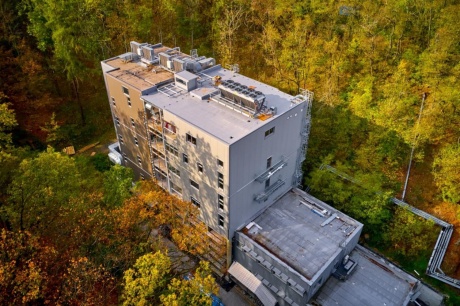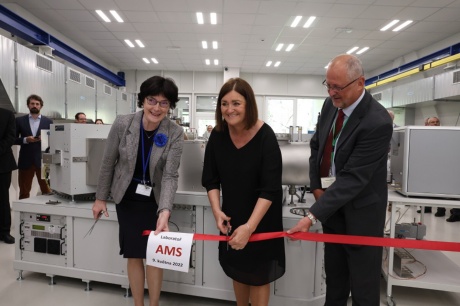New AMS Lab Will Enable Excavation Dating and Searching for Nuclear Weapons
The most accurate method of nuclear reaction analysis, accelerator mass spectrometry (AMS), is capable of detecting up to a million times less radionuclides than other methods.
The most accurate method of nuclear reaction analysis, accelerator mass spectrometry (AMS), is capable of detecting up to a million times less radionuclides than other methods. Its help is invaluable in archaeology, geology, and climate change research. Experts in nuclear forensics, a discipline that monitors compliance with international non-proliferation of nuclear weapons commitments, also utilise AMS. A new unique laboratory equipped with this technique was inaugurated on 9 May 2022 at the Nuclear Physics Institute of the CAS in Řež, Czech Republic, by the President of the CAS, Eva Zažímalová, and the Czech Minister for Science, Research, and Innovation, Helena Langšádlová.
Accelerator Mass Spectrometry (AMS) allows experts to accurately detect long-lived radionuclides of certain specific elements. Radionuclides can occur naturally, for example as a result of cosmic rays, but also through human activity, such as the production of nuclear energy or weapons.

The building housing the accelerator mass spectrometry facility in Řež belongs to the Nuclear Physics Institute of the CAS.
Other methods for the analysis of radionuclides detect particles produced by the process of their decay. However, certain radionuclides decay so slowly that researchers would have to wait hundreds of years for the necessary particles. In the case of the AMS method, the isotope is placed into an accelerator and experts can then quickly separate it without waiting for spontaneous decay. AMS is thus sometimes called the method of “impatient” scientists.
AMS can find use in various scientific fields
Radionuclide levels can reveal a lot about the age of objects. “AMS is by far the most commonly used method for so-called radiocarbon dating: in archaeology, for instance,” explained Petr Lukáš, Director of the Nuclear Physics Institute of the CAS. The new laboratory in Řež near Prague will focus approximately 60% of its time on this type of work.

Eva Zažímalová, President of the CAS, Helena Langšádlová, Czech Minister for Science, Research, and Innovation, and Petr Lukáš, Director of the Nuclear Physics Institute of the CAS at the inauguration of the laboratory
The current equipment of the laboratory allows researchers to study samples of wood, ash, or bones. Future plans, however, include the possibility of examining sediments, historic steel, resins, fats, waxes, or pollen. The advantage of AMS is that large samples do not need to be used for analysis. This makes it suitable for dating fragile specimens such as petroglyphs. For accurate analysis, it is sufficient for the specimen to contain 200 micrograms of carbon. Then its age can be dated up to 60,000 years in the past. The resulting advantages are not only important for archaeology, but also for forensic science, for instance.
Another area where AMS will find its application is in the analysis of biocomponents in fuels. “Thanks to the analysis of radiocarbon, we can distinguish the component of oil that grew in a field last year from that which has been lying belowground for millions of years,” Petr Lukáš noted, pointing out the versatility of the AMS device.
AMS is commonly used to determine the presence of uranium and its fission products. It is thus important in geology and environmental research and protection. It is possible to measure certain radioisotopes in the vicinity of nuclear power plants from field samples. Nuclear safety experts can use AMS to monitor whether certain countries are developing nuclear weapons.
A long-awaited laboratory
This modern and – for our country – unique laboratory has the potential to bring together a number of scientific fields and research institutes. The Czech Republic was one of the last countries in Europe to lack this important type of mass spectrometry, forcing researchers to send all their samples abroad for analysis. “The Czech scientific community has been waiting for this facility for a really long time. So it’s certain that it’ll now be utilised extensively for research,” Petr Lukáš concluded.
Prepared by: Jan Hanáček, Division of External Relations, CAO of the CAS
Photo: PR Department of the CAS; photo of building: Nuclear Physics Institute of the CAS
Original Story Source: Czech Academy of Sciences

 Alerts Sign-up
Alerts Sign-up